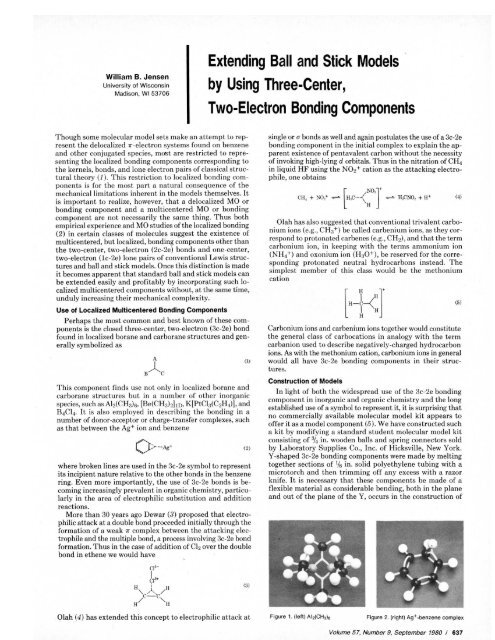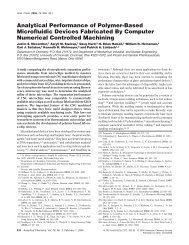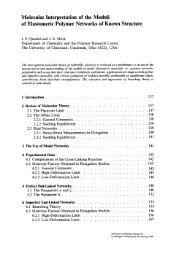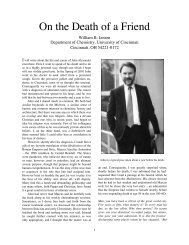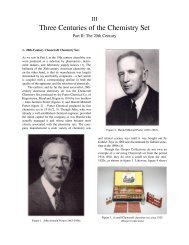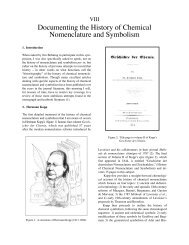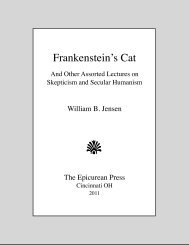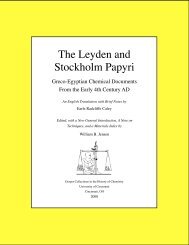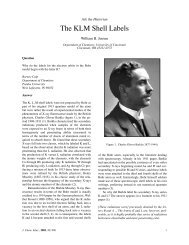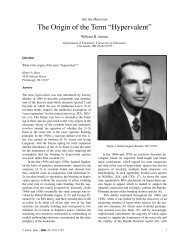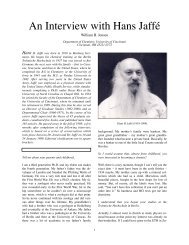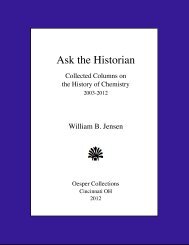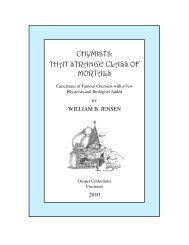014. 3c-2e Bonds.pdf
014. 3c-2e Bonds.pdf
014. 3c-2e Bonds.pdf
- No tags were found...
Create successful ePaper yourself
Turn your PDF publications into a flip-book with our unique Google optimized e-Paper software.
William 6. JensenUniversity of WisconsinMadison, WI 53706I Extending Ball and Stick ModelsI by Using ~hree-center,I Two-Electron Bonding ComponentsThough some molecular model sets make an attempt to rep- single or a bonds as well and again postulates the use of a <strong>3c</strong>-<strong>2e</strong>resent the delocalized a-electron systems found on benzene bonding component in the initial complex to explain the apandother conjugated species, most are restricted to repre- parent existence of pentavalent carbon without the necessitysenting the localized honding components corresponding to of invoking high-lying d orbitals. Thus in the nitration of CHIthe kernels, bonds, and lone electron pairs of classical struc- in liquid HF using the NOz+ cation as the attacking electroturaltheory (I). This restriction to localized bonding com- phile, one obtainsponents is for the most part a natural consequence of the - ..--Amechanical limitations inherent in the models themselves. Itis important to realize, however, that a delocalized MO orLboudine com~onent and a multicentered MO or honding .. Jcompo~ent a;e not necessarily the same thing. Thus hothempirical experience and MO studies of the localized bondingOlah has also suggested that vonventionnl triv~lent rarho-(2) in certain classes of molecules suggest the existence ofnium ions IV.E., CH ; I he valled carlwniwn ions, as they cormulticentered,hut localized, bonding components other thanthe two-center, two-electron (2c-<strong>2e</strong>) bonds and one-center,two-electron (lc-<strong>2e</strong>) lone pairs of conventional Lewis struc-tures ~~~~- and~~~~~~hall~and~ ~stick models. Once this distinction is madeit becomes apparent that standard ball nnd stick models canhe extended easilv and nrofitnl~lv hv incoraoratinr! such Iocalizedmulticentered components without, at the same time,unduly increasing their mechanical complexity." - -Use of Localized Multicentered Bonding ComponentsPerhaps the most common and best known of these componentsis the closed three-center, two-electron (<strong>3c</strong>-<strong>2e</strong>) hondfound in localized borane and carborane structures and generallysymbolized asThis component finds use not only in localized horane andcarborane structures but in a numher of other inorganicspecies, such as Al2(CH&, [Be(CH3)2]1~, K[PtC13(CzH3], andBdC14. It is also employed in describing the honding in anumber of donor-acceptor or charge-transfer complexes, suchas that between the Ag+ ion and benzenewhere broken lines are used in the <strong>3c</strong>-<strong>2e</strong> symbol to representits incipient nature relative to the other bonds in the benzenering. Even more imaortantlv. . the use of <strong>3c</strong>-<strong>2e</strong> bonds is hecomingincreasingly pre\.alent in organicchemistry, particularlvin the area of clectroahilic suhstitution and additionreactions.More than 30 years ago Dewar (3) proposed that electrophilicattack at a double bond proceeded initially through theformation of a weak a complex between the attacking electrophileand the multiple bond, a process involving <strong>3c</strong>-<strong>2e</strong> hondformation. Thus in the case of addition of C12 over the doublebond in ethene we would haverespond to prkonated carbeues (e.g., CHz), and that the termcarhonium ion, in keeping with the terms ammonium ion(NH4+) and oxonium ion (H30+), be reserved for the correspondingprotonated neutral hydrocarbons instead. Thesimplest member of this class would he the methoniumcationCarbonium ions and carbeuium ions together would constitutethe general class of carbocations in analogy with the termcarhanion used to describe negatively-charged hydrocarbonions. As with the methonium cation, carhonium ions in generalwould all have <strong>3c</strong>-<strong>2e</strong> bonding components in their structures.Construction of ModelsIn light of hoth the widespread use of the <strong>3c</strong>-<strong>2e</strong> hondingcomponent in inorganic and organic chemistry and the longestablished use of a symbol to represent it, it is surprising thatno commercially available molecular model kit appears tooffer it as a model component (5). We have constructed sucha kit by modifying a standard student molecular model kitconsisting of 3/4 in. wooden halls and spring connectors soldby Laboratory Supplies Co., Inc. of Hicksville, New York.Y-shaped <strong>3c</strong>-<strong>2e</strong> bonding components were made by meltingtogether sections of '1s in. solid polyethylene tubing with amicrotorch and then trimming off any excess with a razorknife. It is necessary that these components be made of aflexible material as considerable bending, hoth in the planeand out of the plane of the Y, occurs in the construction ofOlah (4) has extended this concept to electrophilic attack at Figure 1. lleh) AIdCH& Figure 2. (right) Agt-benzene complexVolume 57, Number 9, September 1980 / 637
.- The correct shapes. wrrr~~pondin:! to the polyhedra and polyhedraltraementi oredictc.d tw Wade's rules (61. natumll\.Figure 3 (left) Dewar n complex for Clz-CzHnFigure 4. (right) Olah complex for CHI-NO2+-/result fro; "inflaiing" these-styx structures, each boroni having an approximately tetrahedral arrangement of bonds1 and the flexibility of the bonding components allowing forconsiderable distortion from the deal angles if necessarv. Useof any one of the many possible resonance styx structures forthe higher boranes also gives the proper geometry for eachspecies, the choice of the styx structure used being dictatedby the absence of open <strong>3c</strong>-<strong>2e</strong> bonds and (for aesthetic reasons)the symmetry of the components (7). Finally, Figure 6 showsa model for the carborane 2.4-C~BsH7 based on the structure@&$&(71'8QJFigure 5. (left) (a) BIHlo (b) BsHxFigure 6. (right) 2.4-C&H7recently proposed by Lipscomb (2) on the basis of localizedMO calculations.It is apparent from the above examples that commercialproduction of <strong>3c</strong>-<strong>2e</strong> bonding components (and possibly otherlocalized multicentered components such as the 4c-<strong>2e</strong> bondsin Pt4(CH3)16 and Lid(CH&) would substantially enhancethe value of molecular model kits for the inorganic and organicchemist alike.The author would like to thank Mr. Russ Riley for his helpin making the necessary bonding components and Dr. GlennDirreen for photographing the models.also replaced by straight sections of polyethylene tubing togive a uniform representation of all bonding components. The<strong>3c</strong>-<strong>2e</strong> components were cut so that each arch of the Y roughlyspanned a distance equivalent to the longest straight linebonding component (about 1% in.). The tubing was slightlylarger than the holes in the balls and trimming of the ends witha razor insured a secure fit for the bonding components.Some example models are shown in Figures 1 through 6.Figure 1 shows a model of Ala(CH&j, Figure 2 the Ag+-henzenecomplex in eqn. 2, Figure 3 the Dewar a complex in eqn.3, and Figure 4 the CH4-N02+ intermediate in eqn. 4. Figure5 shows models of B4H10 and BeH10 corresponding to thestyxstructures(-21('-21-1 1 4- (6)w 5-411) An extended survey of currently svailablecnmmercial model kits har- recently been givenhy Wailon, A.,"Mc,lecular and Crystel Stmeture Mdels," Halbted Prescr, Chichenter.England. 1978.(2) Reade* interested in the theoretical jurtifieafinn nElncalized hundingeomlwnenfs landconsequently uf ball and stick mudelr in general) and in the distinction between de-Incalined, lueaiired, and multicentered should conult the review by England, w.,Salmon,L.S.,andRuedenberg,K..Furbrhr. Chem Forsch.. 23.31 l1971l.Areview01 localized Mo results for multieenteied bonds in boranes and carboranes can hefound by consultine Lip%cumb. W. N.. Arc. (7,nrn Res, 6.257 119731. ABBRIY~~ dthis work Lipscnmb has suggested ceitain modifications ui the eonventianal sly=picttms:see Eprtein. I. R. and Lipscomb. W. N..lnon. Chem.. 10,1921 l19711.I31 Dpwar. M. J. S.. "The Elec~onieThpowofO~gsnicChemirfw."Oxford Univemity Press.oxford, ,949.I41 Oiah. G.. "Carhorationn and Eleetrophilie Reactions: Wilev, New York, 1974.151 The only malecular modeis 1 nm aware of which attemptto represent 3e-<strong>2e</strong> bond3 arebardon the tangent-sphere malelpopularized by Bent IseeBent, H.,Forischr. Chsm.Forsch.. 14, 1 119701! and commonly used to represent Gillespie's VSEPR. rules forpredicting molecular geometry. Model kit3 based 0" the use "f pla~tie sphere. andrubber bands have heen extensively used by King lkee King. L. C., Ch~misliy. 37 121,12 I19641l U represent such tangent-3pheredomains.and Sunderwfrth IseeSunderuirth.S.G., J. CHEM. EDUC.. 47.728 119701) hasgiven sometangent-sphere malelrof 3e-<strong>2e</strong> bonded fritermediates in organic chemistry.Ifii Wade, K..Chrm. Rrit., 11.177 (1976).171 Lipscomb. W. N., "Boron Hydrides," Benjamin. NewYork. 1963.


